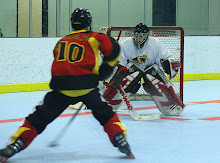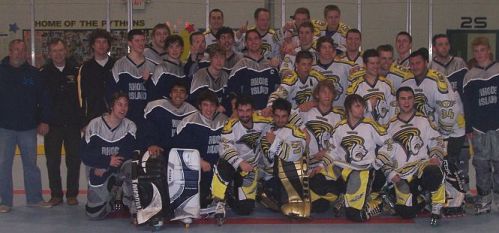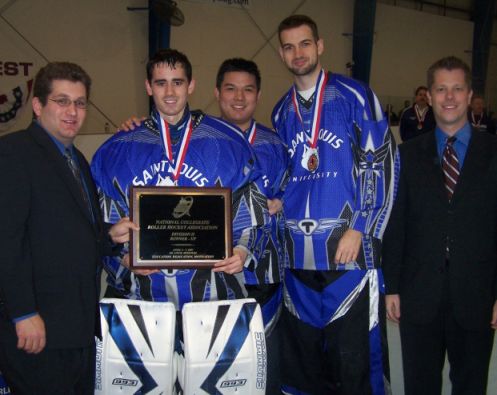Thursday, June 4, 2009
Final Rankings & All-Americans Posted
I apologize for not being able to update this information sooner. I was unexpectedly called out of the country for business and didn't have access to the program I use to calculate the rankings.
Congratulations to UMSL, Grand Valley State, Saddleback College and Lindenwood Gold on their respective NATIONAL CHAMPIONSHIPS!
Congratulations to UMSL, Grand Valley State, Saddleback College and Lindenwood Gold on their respective NATIONAL CHAMPIONSHIPS!
2008-2009 Division I All-Americans
First Team:
PJ Tallo - University of Missouri - St. Louis
Kyle Gouge - Lindenwood University
Tyler Walser - University at Buffalo
Mike Tasch - UC Irvine
Goalie - Jimmy Steger - University of Missouri - St. Louis
Second Team:
Alex Durinka - University at Buffalo
Michael Fenkell - Michigan State University
Brandon Barnette - Lindenwood University
Jeff Hill - Lindenwood University
Goalie: Richie LaTona - University at Buffalo
Honorable Mention:
Mike Inge - Towson University
Connor Cafferty - University of Central Florida
Dustin Roux - Penn State University
Michael Thiefault - Lindenwood University
Goalie - Dave Thomas - Lindenwood University
PJ Tallo - University of Missouri - St. Louis
Kyle Gouge - Lindenwood University
Tyler Walser - University at Buffalo
Mike Tasch - UC Irvine
Goalie - Jimmy Steger - University of Missouri - St. Louis
Second Team:
Alex Durinka - University at Buffalo
Michael Fenkell - Michigan State University
Brandon Barnette - Lindenwood University
Jeff Hill - Lindenwood University
Goalie: Richie LaTona - University at Buffalo
Honorable Mention:
Mike Inge - Towson University
Connor Cafferty - University of Central Florida
Dustin Roux - Penn State University
Michael Thiefault - Lindenwood University
Goalie - Dave Thomas - Lindenwood University
2008-2009 Division II All-Americans
First Team:
Jason Yokubison - Central Michigan University
Jon Donohue - Neumann College
Rowan Porter - University of Tampa
Jason Walker - SIU - Edwardsville
Goalie: Keith Chapman - Grand Valley State
Second Team:
Kenny McCubbins - UC San Diego
Cameron Rowand - Rowan University
Drake Fallah - Florida Atlantic University
Eric Keene - West Chester University
Goalie: Alex Florio - Elon University
Honorable Mention:
Greg Boyd - Florida Atlantic University
Danny Bara - Central Michigan University
Drew Vandas - Truman State University
Sean Sheridan - Shippensburg University
Goalie: Brian Scott - West Chester University
Jason Yokubison - Central Michigan University
Jon Donohue - Neumann College
Rowan Porter - University of Tampa
Jason Walker - SIU - Edwardsville
Goalie: Keith Chapman - Grand Valley State
Second Team:
Kenny McCubbins - UC San Diego
Cameron Rowand - Rowan University
Drake Fallah - Florida Atlantic University
Eric Keene - West Chester University
Goalie: Alex Florio - Elon University
Honorable Mention:
Greg Boyd - Florida Atlantic University
Danny Bara - Central Michigan University
Drew Vandas - Truman State University
Sean Sheridan - Shippensburg University
Goalie: Brian Scott - West Chester University
2008-2009 Junior College All-Americans
First Team:
James Irwin - Saddleback College
Rob Alexander - Saddleback College
Nick Smolinski - Macomb Community College
Anay Draper - St. Charles Community College
Goalie: Taz Viloria - Saddleback College
Second Team:
Craig Crow - Red Rocks Community College
Ryan Riker - Suffolk County Community College
Matt Johnson - St. Charles Community College
Kenny Gales - St. Charles Community College
Goalie: Ryan Wooldridge - St. Charles Community College
Honorable Mention:
Tyler Fick - Saddleback College
Max Stern - Suffolk County Community College
Shaun Murphy - Macomb Community College
Brian Villareal - Arapahoe Community College
Goalie: Alex Parisi - Suffolk County Community College
James Irwin - Saddleback College
Rob Alexander - Saddleback College
Nick Smolinski - Macomb Community College
Anay Draper - St. Charles Community College
Goalie: Taz Viloria - Saddleback College
Second Team:
Craig Crow - Red Rocks Community College
Ryan Riker - Suffolk County Community College
Matt Johnson - St. Charles Community College
Kenny Gales - St. Charles Community College
Goalie: Ryan Wooldridge - St. Charles Community College
Honorable Mention:
Tyler Fick - Saddleback College
Max Stern - Suffolk County Community College
Shaun Murphy - Macomb Community College
Brian Villareal - Arapahoe Community College
Goalie: Alex Parisi - Suffolk County Community College
Final 2008-2009 Division I Rankings
#1 – University of Missouri-St. Louis - 2418.52
#2 - Lindenwood University - 2319.28
#3 - Michigan State University - 2154.84
#4 - University at Buffalo - 2081.10
#5 - University of Rhode Island - 1891.84
#6 - California State University, Long Beach - 1873.46
#7 - University of Louisiana at Lafayette - 1843.44
#8 - Rutgers University - 1817.83
#9 - University of Florida - 1796.19
#10 - The Ohio State University - 1782.73
#11 - University of Missouri - 1781.45
#12 - Towson University - 1776.80
#13 - University of Central Florida - 1773.17
#14 - University of Nevada, Las Vegas - 1767.38
#15 - Louisiana State University - 1765.43
#16 - University of California, Irvine - 1718.22
#17 - Stony Brook University - 1713.04
#18 - University of California, Santa Barbara - 1658.18
#19 - University of Michigan - 1644.91
#20 - Colorado State University - 1603.98
#21 - Sam Houston State University - 1595.83
#22 - Penn State University - 1585.31
#23 - San Diego State University - 1578.98
#24 - Eastern Michigan University - 1538.58
#25 - University of North Texas - 1509.35
#2 - Lindenwood University - 2319.28
#3 - Michigan State University - 2154.84
#4 - University at Buffalo - 2081.10
#5 - University of Rhode Island - 1891.84
#6 - California State University, Long Beach - 1873.46
#7 - University of Louisiana at Lafayette - 1843.44
#8 - Rutgers University - 1817.83
#9 - University of Florida - 1796.19
#10 - The Ohio State University - 1782.73
#11 - University of Missouri - 1781.45
#12 - Towson University - 1776.80
#13 - University of Central Florida - 1773.17
#14 - University of Nevada, Las Vegas - 1767.38
#15 - Louisiana State University - 1765.43
#16 - University of California, Irvine - 1718.22
#17 - Stony Brook University - 1713.04
#18 - University of California, Santa Barbara - 1658.18
#19 - University of Michigan - 1644.91
#20 - Colorado State University - 1603.98
#21 - Sam Houston State University - 1595.83
#22 - Penn State University - 1585.31
#23 - San Diego State University - 1578.98
#24 - Eastern Michigan University - 1538.58
#25 - University of North Texas - 1509.35
Final 2008-2009 Division II Rankings
#1 – Grand Valley State - 2076.80
#2 - Neumann College - 2051.45
#3 - University of California, San Diego - 2041.75
#4 - West Chester University - 1980.20
#5 - Central Michigan University - 1955.79
#6 - Missouri State University - 1827.28
#7 - Truman State University - 1810.32
#8 - Rowan University - 1801.53
#9 - Florida Atlantic University - 1778.22
#10 - Elon University - 1735.32
#11 - State University of New York, Brockport - 1673.93
#12 - Drexel University - 1667.61
#13 - Shippensburg University - 1653.66
#14 - University of Tampa - 1615.24
#15 - Kennesaw State University - 1596.77
#16 - University of Texas, Dallas - 1587.63
#17 - Western Carolina University - 1572.62
#18 - Slippery Rock University - 1545.95
#19 - University of Cincinnati - 1544.55
#20 - College of Charleston - 1532.44
#21 - Cal Poly Pomona - 1506.52
#22 - James Madison University - 1502.95
#23 - Metropolitan State College of Denver - 1493.68
#24 - Southern Illinois University, Edwardsville - 1490.21
#25 - Millersville University - 1480.22
#2 - Neumann College - 2051.45
#3 - University of California, San Diego - 2041.75
#4 - West Chester University - 1980.20
#5 - Central Michigan University - 1955.79
#6 - Missouri State University - 1827.28
#7 - Truman State University - 1810.32
#8 - Rowan University - 1801.53
#9 - Florida Atlantic University - 1778.22
#10 - Elon University - 1735.32
#11 - State University of New York, Brockport - 1673.93
#12 - Drexel University - 1667.61
#13 - Shippensburg University - 1653.66
#14 - University of Tampa - 1615.24
#15 - Kennesaw State University - 1596.77
#16 - University of Texas, Dallas - 1587.63
#17 - Western Carolina University - 1572.62
#18 - Slippery Rock University - 1545.95
#19 - University of Cincinnati - 1544.55
#20 - College of Charleston - 1532.44
#21 - Cal Poly Pomona - 1506.52
#22 - James Madison University - 1502.95
#23 - Metropolitan State College of Denver - 1493.68
#24 - Southern Illinois University, Edwardsville - 1490.21
#25 - Millersville University - 1480.22
Final 2008-2009 Junior College Rankings
#1 – Saddleback College - 1867.45
#2 – St. Charles Community College - 1696.96
#3 - Suffolk County Community College - 1578.23
#4 - Red Rocks County Community College - 1568.68
#5 – Front Range Community College - 1463.88
#2 – St. Charles Community College - 1696.96
#3 - Suffolk County Community College - 1578.23
#4 - Red Rocks County Community College - 1568.68
#5 – Front Range Community College - 1463.88
Final 2008-2009 B Division Rankings
#1 - Lindenwood University Gold - 1652.37
#2 - University at Buffalo - 1726.36
#3 - West Chester University - 1637.74
#4 - Penn State University - 1605.78
#5 - Michigan State University - 1579.52
#6 - University of Missouri-St. Louis - 1578.38
#7 - University of California, Santa Barbara Gold - 1563.40
#8 - University of Central Florida - 1524.57
#9 - Colorado State University - 1518.68
#10 - Grand Valley State - 1491.58
#11 - Lindenwood University Black - 1452.87
#12 - Suffolk County CC Gold - 1435.43
#13 - Temple University - 1410.42
#14 - Texas Tech University - 1408.26
#15 - Arizona State University - 1389.93
#16 - Saddleback College - 1361.78
#17 - St. Charles CC - 1347.93
#18 - Towson University - 1340.50
#19 - Ohio State University - 1327.49
#20 - University of California, Santa Barbara Blue - 1324.31
#2 - University at Buffalo - 1726.36
#3 - West Chester University - 1637.74
#4 - Penn State University - 1605.78
#5 - Michigan State University - 1579.52
#6 - University of Missouri-St. Louis - 1578.38
#7 - University of California, Santa Barbara Gold - 1563.40
#8 - University of Central Florida - 1524.57
#9 - Colorado State University - 1518.68
#10 - Grand Valley State - 1491.58
#11 - Lindenwood University Black - 1452.87
#12 - Suffolk County CC Gold - 1435.43
#13 - Temple University - 1410.42
#14 - Texas Tech University - 1408.26
#15 - Arizona State University - 1389.93
#16 - Saddleback College - 1361.78
#17 - St. Charles CC - 1347.93
#18 - Towson University - 1340.50
#19 - Ohio State University - 1327.49
#20 - University of California, Santa Barbara Blue - 1324.31
Subscribe to:
Comments (Atom)
The Rankings Explained
Since the conclusion of the season both founders set out to find the best solution to answer the age old question, “Who’s #1?” After much search, the answer was to use a mathematical formula to calculate the answer. Removing the human element from the voting would likely result in less biased rankings towards individual teams and regions.
The solution would be found in the ELO chess rating system. They system was created to rank chess players by another means that wins, losses and draws. The system uses a mathematical formula to reward each person for impressive feats and punish them for lesser impressive feats. Because chess and inline hockey are two different animals, the general equation had to be changed to allow for more hockeys related factors into the equation.
Using the FIFA Women’s World Rankings as a guideline (Elo Based), we managed to change the rankings to suit the nature of our sport. The rankings include the importance of the game, the outcome of the game, the expected result of the game, and the goal differential of the game when calculating a result. To better explain the way the rankings work I give you the following examples (all team start with a ranking of 1500):
Lindenwood University (1500) vs. UMSL (1500): If Lindenwood won the regular season game 4-3; they would be awarded 15 points for the victory and UMSL would be docked 15 points. However, if the game was won 12-2, Lindenwood would earn 39.38 points for the victory and UMSL would be docked 39.38 points. Additionally, the importance of the game could change, using the national title game as the example, with both teams having equal ratings Lindenwood would be awarded 52.5 points for a 6-3 win.
However, as you could assume, two teams having the same rating would be rare. Each teams point total carries over from one week to the next and from one season to the next. The following is a example of two teams with different point values and the different results it can produce.
Lindenwood University (1746.38) vs. Illinois State (1360.88): There are a few things that you can determine because of the vast difference in each teams rating (385.5). The first is that Lindenwood is expected to win the game. The second is that Illinois State winning the game would be a much bigger accomplishment that Lindenwood winning the game. The maximum points Lindenwood can earn from this game is 7.72, which would mean they won by at least 10 goals. However, on the flip side, if Illinois State was to win the game by at least 10 goals they could earn as many as 71.03 points. This is based on the projection that Lindenwood would win the match-up 90% of the time.
As the two examples show, there are a bunch of positives when using this system. For starters, once a team has achieved a high rating, it becomes difficult for them to increase it without playing a higher level of competition. This rewards regions that have more competitive teams. It also rewards teams who travel out of the region and win games against other higher rated teams. For example, last season, Towson and Army both played James Madison who would have had a higher rating that both visiting teams. In the games, Army and Towson both won handily and would have increased their ratings while negatively hurting James Madison. But, the hidden bonus is they now can bring those rating points back into their region. Those points then become spread out over the entire region as the season progresses and teams win and lose.
For the ratings system to work, each game has to have a certain amount of value attached to it. In the system we will be using five different levels to rate the importance of any give game. The first level is the lowest level of importance; it contains all pre-season exhibition games. The second level includes all regular-season regional games, as well as cross-divisional exhibition games. Level three includes all cross-regional games and invitational based tournaments, like WinterFest. The fourth level includes all regional playoff games and the fifth and final level includes all national playoff games.
The solution would be found in the ELO chess rating system. They system was created to rank chess players by another means that wins, losses and draws. The system uses a mathematical formula to reward each person for impressive feats and punish them for lesser impressive feats. Because chess and inline hockey are two different animals, the general equation had to be changed to allow for more hockeys related factors into the equation.
Using the FIFA Women’s World Rankings as a guideline (Elo Based), we managed to change the rankings to suit the nature of our sport. The rankings include the importance of the game, the outcome of the game, the expected result of the game, and the goal differential of the game when calculating a result. To better explain the way the rankings work I give you the following examples (all team start with a ranking of 1500):
Lindenwood University (1500) vs. UMSL (1500): If Lindenwood won the regular season game 4-3; they would be awarded 15 points for the victory and UMSL would be docked 15 points. However, if the game was won 12-2, Lindenwood would earn 39.38 points for the victory and UMSL would be docked 39.38 points. Additionally, the importance of the game could change, using the national title game as the example, with both teams having equal ratings Lindenwood would be awarded 52.5 points for a 6-3 win.
However, as you could assume, two teams having the same rating would be rare. Each teams point total carries over from one week to the next and from one season to the next. The following is a example of two teams with different point values and the different results it can produce.
Lindenwood University (1746.38) vs. Illinois State (1360.88): There are a few things that you can determine because of the vast difference in each teams rating (385.5). The first is that Lindenwood is expected to win the game. The second is that Illinois State winning the game would be a much bigger accomplishment that Lindenwood winning the game. The maximum points Lindenwood can earn from this game is 7.72, which would mean they won by at least 10 goals. However, on the flip side, if Illinois State was to win the game by at least 10 goals they could earn as many as 71.03 points. This is based on the projection that Lindenwood would win the match-up 90% of the time.
As the two examples show, there are a bunch of positives when using this system. For starters, once a team has achieved a high rating, it becomes difficult for them to increase it without playing a higher level of competition. This rewards regions that have more competitive teams. It also rewards teams who travel out of the region and win games against other higher rated teams. For example, last season, Towson and Army both played James Madison who would have had a higher rating that both visiting teams. In the games, Army and Towson both won handily and would have increased their ratings while negatively hurting James Madison. But, the hidden bonus is they now can bring those rating points back into their region. Those points then become spread out over the entire region as the season progresses and teams win and lose.
For the ratings system to work, each game has to have a certain amount of value attached to it. In the system we will be using five different levels to rate the importance of any give game. The first level is the lowest level of importance; it contains all pre-season exhibition games. The second level includes all regular-season regional games, as well as cross-divisional exhibition games. Level three includes all cross-regional games and invitational based tournaments, like WinterFest. The fourth level includes all regional playoff games and the fifth and final level includes all national playoff games.









